|
Additional Lessons |
 About These
Lessons About These
Lessons
The following classroom lessons are great for students
who want additional listening and reading practice. |
-
Travel America -
Beginner
Level. Do you love America and American
English? Learn before you travel. Facts and other
cool stuff about your favorite U.S. state. Great
English reading practice.
|
 Travel
America - New Mexico Travel
America - New Mexico
(Beginner -
Reading)
Learn some interesting facts and read interesting
stories about New Mexico. |
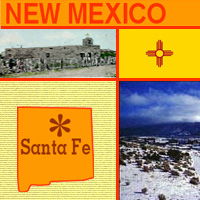 New
Mexico New
Mexico
In 1540, the Spanish conquistador Coronado trekked
through the area known today as New Mexico in search
of the fabled seven cities of gold. New Mexico,
called the "Land of Enchantment," was the 47th
state, entering the Union in 1912. Part of the "Old
West," New Mexico was a place known for cowboys and
cattle drives. The influence of the Apache Indians
who live there is evident in the artwork and
culture. The Pueblo Indian presence is also very
apparent, most visibly in the tribe's buildings. The
state also has a large Hispanic population, as New
Mexico was under Spanish control from the 16th
century until about 1846. The capital city of Santa
Fe, founded in 1610, has the oldest continually used
seat of government in North America. The state
flower is the yucca. |
New Mexico
State Flag
The colors on New Mexico's state flag are the red
and yellow of old Spain. The simple, elegant center design
is the ancient Zia sun symbol, which represents the unique
character of New Mexico (Zia sun symbol also appears on New
Mexico's state quarter).
The Zia Indians of New Mexico regard the Sun as sacred.
Their symbol for the sun (a red circle with groups of rays
pointing in four directions) is painted on ceremonial vases,
drawn on the ground around campfires, and used to introduce
newborns to the Sun.
Four is the sacred number of the Zia and is seen repeated in
the four points radiating from the circle, each consisting
of four bars. To the Zia Indians, the number four
represents:
the four points of the compass (east, west, north, and
south);
the four seasons of the year (spring, summer, autumn, and
winter);
the four periods of each day (morning, noon, evening, and
night);
the four seasons of life (childhood, youth, middle years,
and old age);
the Zia's belief that with life comes four sacred
obligations: one must develop a strong body, a clear mind, a
pure spirit, and a devotion to the welfare of others.
Official salute to the flag of New
Mexico
"I salute the flag of the state of New Mexico, the Zia
symbol of perfect friendship among united cultures." |
|
Source:
State Symbols USA |
|
|
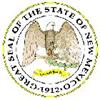 New Mexico
State Facts New Mexico
State Facts
Picture: state seal of New Mexico |
|
State Capital |
Santa Fe |
|
Nickname |
Land of Enchantment |
|
Motto |
Crescit Eundo (It Grows As It Goes) |
|
Statehood |
January 6, 1912 (47th) |
|
Origin of Name |
Named by the Spanish for lands north of the Rio
Grande River. |
|
Largest Cities |
Albuquerque, Las Cruces, Santa Fe, Rio Rancho,
Roswell |
|
Border States |
Arizona, Colorado, Oklahoma, Texas, Utah |
|
Area |
121,359 sq. mi., 5th largest |
|
State Bird |
Roadrunner |
|
State Flower |
Yucca Flower (yucca glauca) |
|
State Tree |
Piñon (pinus edulis) |
|
State Song |
O, Fair New Mexico Asi es Nuevo Mejico |
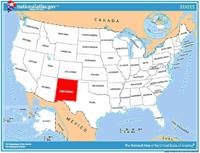 Travel and
tourism site for New Mexico - This state travel and
territorial tourism site provides ideas for your vacations,
meetings, and more. Travel and
tourism site for New Mexico - This state travel and
territorial tourism site provides ideas for your vacations,
meetings, and more. |
|
|
New Mexico Stories |
|
|
The Spanish Market
Have you ever heard of bultos? The artist in this photograph poses
with his bultos, -- brightly colored sculptures of saints or other
religious figures. This artist is called an ultossantero
(saint-maker) and is one of many at the Spanish Market in Santa Fe,
New Mexico.
In 1926, the Spanish Colonial Arts Society started the Spanish
Market for Hispanic artists to show and sell their traditional
handmade objects. The Society began the Market to preserve and
celebrate the Hispanic culture of New Mexico.
The artists of the Spanish Market work with many different kinds of
materials. Some weave cloth on looms or punch designs into tin.
Others make their own pottery or carve objects out of bone. The
artist in this photograph poses with his bultos, which are brightly
colored sculptures of saints or other religious figures. Local
artists, called santeros (saint-makers), have carved and painted
bultos for the past few hundred years. Today, they still carve the
figures from the wood of trees that grow in New Mexico: cottonwood,
cottonwood roots, aspen and pine. A santero carves a bulto with a
knife and then covers it with gesso, a kind of paste, to prepare it
for painting. Santeros still use paints from homemade pigments. For
example, charcoal is used to make black paint. After a santero has
finished painting, he applies a varnish to protect the bulto. |
|
|
Taos Pueblo, New Mexico
Do you know what a pueblo (pronounced pway-blow) is?
It is an Indian community made up of a large cluster of buildings
meant to house many families. Taos Pueblo is a Pueblo Indian
community in New Mexico that is thought to be around 600 years old
and is still used as a residence. The buildings' walls are made of
adobe, or sun-dried mud brick, that is two-feet thick in some
places. The roofs consist of cedar logs, mats, branches, grass, and
adobe. The pueblo's residents originally entered the building
through small, low doors or climbed down ladders through rooftop
entrances. These entryways would have forced invaders to stoop or
climb in order to enter the building. The entrances became less
necessary as threat of invasion decreased, and today the pueblo has
many more large doors and windows. Today visitors may come to see
the dwellings and watch ceremonies in order to learn about
traditional Pueblo Indian life. |
|
|
Kodak Albuquerque International Balloon
Fiesta
Aren't those colorful balloons in the photo a beautiful sight?
Every October, several hundred hot-air balloons fly through the air
in the Kodak Albuquerque International Balloon Fiesta. More than a
million people come to watch the event.
A balloon can fly in the air because hot air rises. To launch a
hot-air balloon, the pilot first makes sure the basket is tied
securely to the ground, so it doesn't suddenly fly off. Then the
fabric of the balloon, or the envelope, is spread on the ground. A
fan blows air into the envelope to help open it. As it opens, the
pilot uses a propane (a kind of gas) burner to blow hot air into the
envelope. The balloon then rises as it is inflated with the hot air
until it is upright. When the pilot gives a signal, the basket is
untied, and there is lift-off. The pilot uses the propane burner to
control how high or low the balloon flies. To go up, he or she turns
up the burner to make the air in the envelope hotter. To go down,
the pilot just lets the air cool down. |
|
|
Zozobra Festival
What is Zozobra? It's the Spanish word for "the gloomy one."
Every year in Santa Fe, New Mexico, the Kiwanis Club starts off the
annual Fiestas de Santa Fe with the burning of Zozobra, an effigy of
Old Man Gloom. An effigy is an image or figure that represents a
person -- usually a disliked one. To the people of Santa Fe, Old Man
Gloom represents the hardships and difficulties of the past year.
They burn him in effigy to clear away the gloom and bring in a new,
better year. The burning is a kind of ritual, or symbolic act.
Zozobra is a giant puppet made of sticks covered with chicken wire
and muslin, a cotton fabric. He is stuffed with lots of shredded
paper. Creating Zozobra every year is a big project, especially
because he gets larger every year. In 1999, the effigy was 51 feet
tall!
Zozobra waves his arms and growls as he is brought out to be burned.
Dancers perform around him as the crowds yell for their bad luck --
and Zozobra -- to go away. |
|
|
International UFO Museum and Research Center
Do you know about the incident reported at Roswell, New Mexico, in
1947?
Many people believe that aliens, or extraterrestrials, crash-landed
near Roswell in July 1947. A rancher claimed that he found wreckage
made of unusual metal that many think was from a flying saucer. The
United States military collected the wreckage and at first announced
that it was indeed from a flying saucer. However, soon after,
military officials insisted a mistake had been made, and that the
wreckage was from a weather balloon. For many people, the truth
about the Roswell incident remains a mystery.
Anyone interested in UFOs and aliens would probably want to visit
the International UFO Museum and Research Center, which was founded
in 1991 in Roswell. UFO is an abbreviation for "unidentified flying
object," which is an object in the air that cannot be easily
explained. Over the years, many people say they have seen UFOs.
However, the objects usually turn out to be things that can be
explained, such as meteors, balloons, or even birds.
Do you believe in UFOs? |
|
|
Expresiones Dance Company
New Mexican dance has many influences - even hip-hop.
The Expresiones Dance Company performs traditional dances and music
from all over Mexico. The performers also include other dance styles
found in New Mexico culture, such as hip-hop, Latin, and Azteca, an
old Mexican dance with a religious flavor. The dance company has
performed not just in New Mexico but all over the United States,
including Texas, Colorado, Kentucky, and even Disney World's Epcot
Center in Florida. The dancers have also appeared on national
television.
New Mexico culture has been shaped by many different groups of
people over the centuries. Indians such as the Navajo, Pueblo,
Apache, and Ute, have lived there for thousands of years. Beginning
in the 1500s, the Spanish explored and settled in the area. In the
1800s, New Mexico became a part of Mexico and then of the United
States. Through their performances, the dancers of the Expresiones
Dance Company help preserve this complex culture and tradition of
New Mexico. |
|
|
The Ralph Edwards Fiesta: How Hot Springs,
New Mexico, Became Truth or Consequences
Can you guess how a town that used to be called Hot Springs got the
unusual name of Truth or Consequences?
Ralph Edwards was the host of a radio show called "Truth or
Consequences." It was the show's 10th anniversary in 1950, and he
wanted to find a way to honor this event. So, Edwards offered to
broadcast the show from any city that would change its name to Truth
or Consequences. Some people in Hot Springs, in southwestern New
Mexico, thought it was a good idea, so they held a special election
and residents voted in favor of the name change.
On April 1, 1950, Ralph Edwards hosted his radio show, "Truth or
Consequences" from Truth or Consequences, New Mexico. The town also
held a big celebration. Every year since then, Edwards returned to
Truth or Consequences to host the annual celebration, or fiesta,
which is now named after him. |
|
Source:
Library of Congress |
|
 National
Forests, Parks, and Monuments of New Mexico National
Forests, Parks, and Monuments of New Mexico
The following is a description of national
forests, parks, and monuments in the state
of New Mexico. If you plan to visit or live
in New Mexico for awhile then you should
definitely plan to visit some of these
fantastic places. |
|
|
|
National Forests |
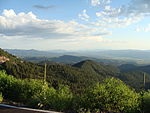 Apache-Sitgreaves Apache-Sitgreaves
Encompassing the Mogollon Rim and White
Mountains, this forest includes 34 lakes and
over 680 miles (1,090 km) of rivers and
streams, more than any other National Forest
in the arid Southwest. This national forest
is also partially located in the state of
Arizona. |
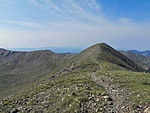 Carson Carson
In the Sangre de Cristo Mountains, this
forest has over 330 mi (530 km) of trails
and Taos Ski Valley. The highest point in
the forest is Wheeler Peak, also New
Mexico's highest point, at 13,161 ft (4,011
m). |
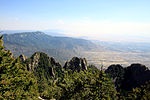 Cibola Cibola
Part of this National Forest are four
wilderness areas, including the Sandia
Mountain Wilderness east of Albuquerque.
Elevations range from 5,000 ft (1,500 m) to
11,301 ft (3,445 m) at the summit of Mount
Taylor, a stratovolcano in the San Mateo
Mountains. |
 Coronado Coronado
Covering the sky islands of the Southwest,
Coronado National Forest also includes Mount
Wrightson and the birding destination of
Madera Canyon. There are eight wilderness
areas in the forest as well as observatories
on Mount Hopkins and Mount Lemmon. This
national forest is also partially located in
the state of Arizona. |
 Gila Gila
The forest's Gila Wilderness was the world's
first wilderness area and was proclaimed on
June 3, 1924. The Catwalk National
Recreation Trail travels up a narrow canyon
for 1.1 mi (1.8 km) while following
Whitewater Creek. |
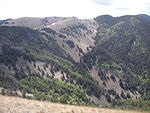 Lincoln Lincoln
With portions of four mountain ranges, the
Capitan, Guadalupe, Sacramento, and Sierra
Blanca mountains, elevations range from
4,000 ft (1,200 m) to 11,500 ft (3,500 m) in
Lincoln National Forest. The forest was the
birthplace of Smokey Bear. |
 Santa
Fe Santa
Fe
Santa Fe National Forest's highest point is
Truchas Peak at 13,103 ft (3,994 m) in the
Pecos Wilderness. There are 1,002 mi (1,613
km) of trails in the forest, which includes
the Valles Caldera National Preserve. |
|
|
|
National Parks |
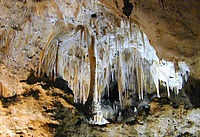 Carlsbad
Caverns Carlsbad
Caverns
Carlsbad Caverns has 117 caves, the longest
of which is over 120 miles (190 km) long.
The Big Room is almost 4,000 feet (1,200 m)
long, and the caves are home to over 400,000
Mexican free-tailed bats and sixteen other
species. Above ground are the Chihuahuan
Desert and Rattlesnake Springs. |
|
|
|
National Monuments |
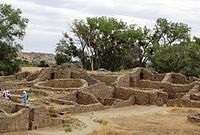 Aztec
Ruins Aztec
Ruins
The ruins contain Pueblo structures from the
11th to 13th centuries with more than 400
masonry rooms which were misidentified by
early American settlers as Aztec. It has
been included in the Chaco Culture World
Heritage Site, which also includes Chaco
Culture National Historical Park. |
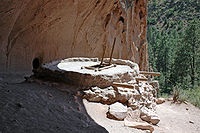 Bandelier Bandelier
A historic district, Bandelier contains
Frijoles Canyon, which contains Ancestral
Pueblo homes, kivas, rock paintings and
petroglyphs. |
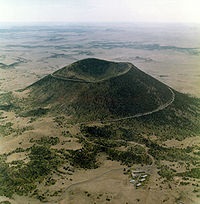 Capulin
Volcano Capulin
Volcano
Capulin is an extinct cinder cone volcano
that is approximately 59,000 years old and
part of the Raton-Clayton Volcanic Field.
The crater is 400 feet (120 m) deep and its
rim is more than 1,500 feet (460 m) in
diameter. |
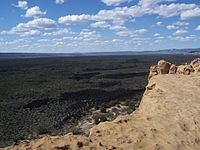 El
Malpais El
Malpais
An extremely rough, rugged lava flow covers
much of the park, filling a large basin
rimmed by higher sandstone that forms large,
wind-carved bluffs. It has lava tube caves
that stretch over 17 miles (27 km) and the
Cebolla Wilderness, a forested rimrock area
that features prehistoric rock art and the
Zuni-Acoma Trail, an ancient Pueblo trade
route. |
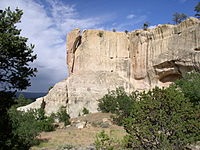 El
Morro El
Morro
On the site of an ancient east-west trail is
a great sandstone promontory with a pool of
water at its base. There are inscriptions
from the 17th century as well as older
petroglyphs made by the Ancestral Puebloans. |
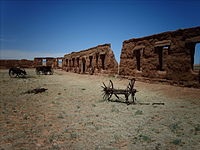 Fort
Union Fort
Union
A frontier military post and supply depot in
the late 19th century, it sat at the
intersection of the Mountain and Cimarron
Branches of the old Santa Fe Trail. |
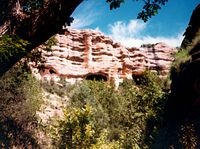 Gila
Cliff Dwellings Gila
Cliff Dwellings
Located within the Gila Wilderness, the
people of the Mogollon culture lived in
these cliff dwellings 180 feet (55 m) above
the canyon floor from the 1280s through the
early 14th century. They lived in five caves
with 46 rooms. Henry B. Ailman discovered
them in 1878. |
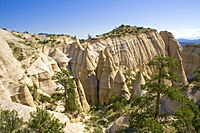 Kasha-Katuwe
Tent Rocks Kasha-Katuwe
Tent Rocks
Kasha-Katuwe is known for its geology of
layers of volcanic rock and ash deposited by
a volcanic explosion. Over time, weathering
and erosion of these layers has created
canyons and tent rocks. The tent rocks
themselves are cones of soft pumice and tuff
beneath harder caprocks. |
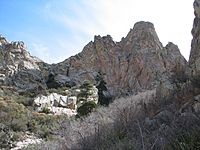 Organ
Mountains-Desert Peaks Organ
Mountains-Desert Peaks
The protected area includes five mountain
ranges that rise above the Chihuahua Desert:
Robledo Mountains, Sierra de las Uvas, Doña
Ana Mountains, Organ Mountains and Potrillo
Mountains. There are approximately 870
vascular plant species, and the area is
popular for hiking and climbing. |
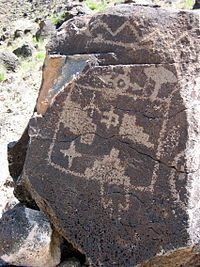 Petroglyph Petroglyph
This monument protects a variety of cultural
and natural resources, including five
volcanic cones, hundreds of archeological
sites and an estimated 25,000 images carved
by native peoples and early Spanish
settlers. It lies on West Mesa, a volcanic
basalt escarpment. |
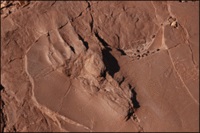 Prehistoric
Trackways Prehistoric
Trackways
Prehistoric Trackways contains fossilized
footprints of numerous Paleozoic amphibians,
reptiles, and insects, as well as fossilized
plants and petrified wood dating back
approximately 280 million years. |
 Río
Grande del Norte Río
Grande del Norte
This site includes part of the Rio Grande
Gorge and extinct volcanoes of the Taos
Plateau volcanic field. There are a variety
of archaeological and historical artifacts
including petroglyphs and Hispanic
settlement sites. It is home to an
assortment of wildlife and recreation
opportunities. |
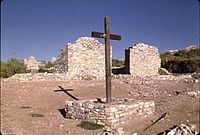 Salinas
Pueblo Missions Salinas
Pueblo Missions
Formerly known as Gran Quivira National
Monument, it is where Native American trade
communities of Tiwa- and Tompiro-speaking
Puebloans lived when Spanish Franciscan
missionaries made contact in the 17th
century. What remains are the ruins of four
mission churches, at Quarai, Abó, and Gran
Quivira, and the partially excavated pueblo
of Las Humanas. |
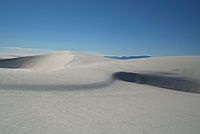 White
Sands White
Sands
Located in the mountain-ringed Tularosa
Basin valley area, White Sands consists of
the southern part of a 275 square miles (710
km2) field of white sand dunes composed of
gypsum crystals. It is completely within the
White Sands Missile Range and is subject to
closure when tests are conducted. |
|
|
Travel America |
|
|
Carlsbad Cavern National Park
(Beginner - Listening,
reading)
A video lesson which shows you an interesting place in America.
The English is
spoken at 75% of normal speed.
Great English listening and reading practice.
This video is all about Carlsbad Cavern National Park. |
|
 Travel
America Travel
America
Do you love America and American English? Learn before
you travel. Facts and other cool stuff about your
favorite U.S. state. Visit the Fun Easy English Travel
America pages. Read about the beautiful National
Forests, Parks, and Monuments. Great English reading practice. |
 Drive America Drive America
Planning to drive in America? Learn the rules and
regulations. Great English reading practice. |
|